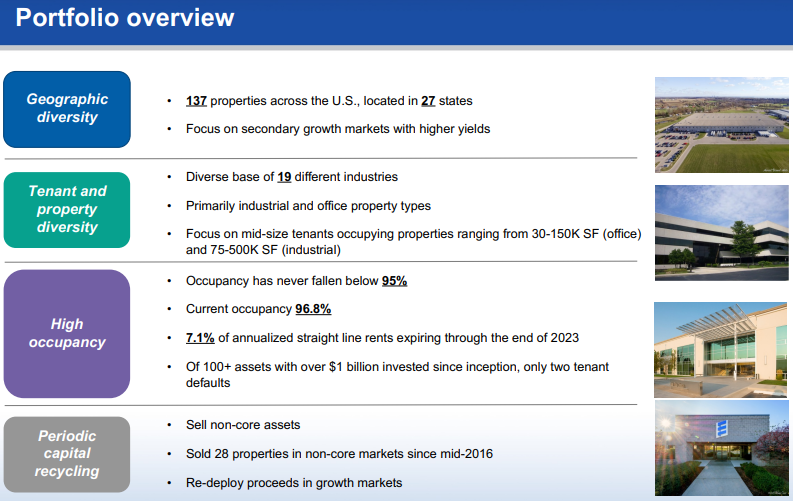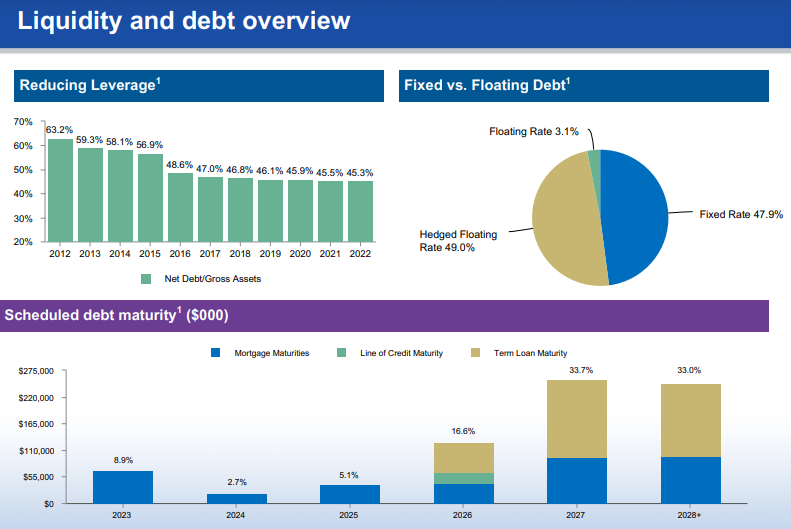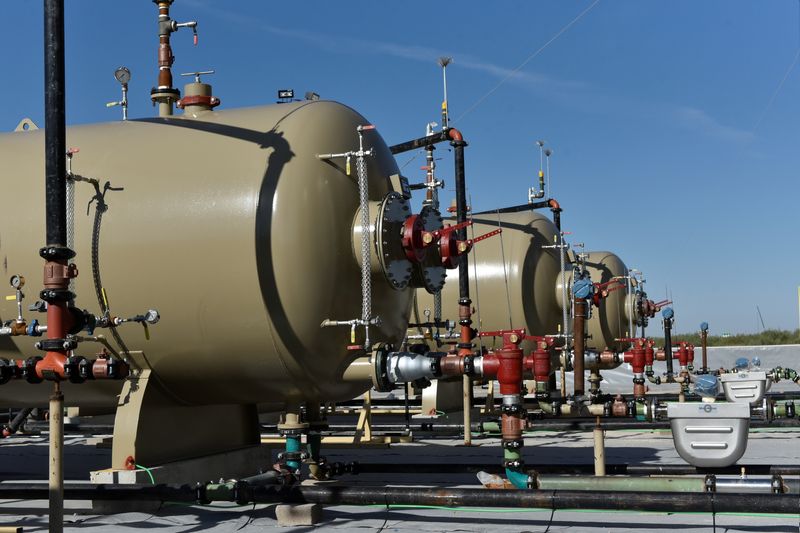Updated on February 27th, 2023 by Samuel Smith
Real Estate Investment Trusts have a lot to offer investors who desire higher levels of investment income, including retirees. For instance, Gladstone Commercial Corporation (GOOD) is a REIT with a high dividend yield of 8.4%.
You can see the full list of 5%+ yielding stocks by clicking here.
Gladstone Commercial appears to be an attractive dividend stock, especially considering the available alternatives. The S&P 500 Index, on average, has about a ~1.6% dividend yield. Plus, Gladstone Commercial is one of only 50 stocks that pays its dividend each month.
You can download our full Excel spreadsheet of all monthly dividend stocks (along with metrics that matter like dividend yield and payout ratio) by clicking on the link below:
However, Gladstone Commercial’s dividend is far from guaranteed. Its payout ratio is almost 100%, leaving little room for error when it comes to maintaining the dividend.
This article will discuss the trust’s business model and financial performance, and why its dividend may be riskier than meets the eye.
Business Overview
Gladstone Commercial is a Real Estate Investment Trust, or REIT, that invests primarily in single-tenant, and anchored multi-tenant net leased assets. It owns 16.2 million square feet of office and industrial real estate in the U.S.
Gladstone Commercial has a very diversified portfolio. As of the end of December 2022, the trust’s portfolio consisted of 137 properties in 27 states, leased to over 100 different tenants in 19 industries.

Source: Investor presentation
The trust’s portfolio is typically geared toward long-term agreements. In addition, Gladstone Commercial enjoys high occupancy rates, including a current rate of 96.8%. Impressively, occupancy has never fallen below 95% since the trust’s IPO in 2003.
Approximately 53% of Gladstone Commercial’s tenants are rated investment grade or are the non-rated investment grade equivalent. This contributes to a high-quality portfolio of tenants that should weather minor economic downturns and preserve Gladstone Commercial’s rent streams.
Gladstone reported fourth quarter earnings on February 22nd, 2023. Q4 FFO available to common shareholders and Non-controlling OP Unitholders amounted to $13.7 million, marking a 19.9% decrease compared to the quarter that ended on September 30, 2022, translating to $0.34 per share. Likewise, core FFO available to common shareholders and Non-controlling OP Unitholders in the quarter that ended on December 31, 2022, decreased by 21.9% when compared to the quarter that ended on September 30, 2022, which amounted to $0.34 per share. The decline in core FFO was primarily due to an increase in SOFR rates on variable rate debt in the quarter, resulting in higher interest expenses. Also, rental income from third and fourth quarter acquisitions partially offset the decline, along with accelerated rental income from a lease termination that the company recognized during the three months that ended on September 30, 2022.
For the entire Fiscal Year 2022, FFO available to common stockholders and Non-controlling OP Unitholders stood at $61.1 million, reflecting a 6.1% increase compared to the year that ended on December 31, 2021, which is equal to $1.54 per share. On the other hand, FFO available to common stockholders and Non-controlling OP Unitholders, as adjusted for comparability, for the year that ended on December 31, 2022, saw a 2.3% increase when compared to the year that ended on December 31, 2021, amounting to $1.54 per share. Core FFO available to common stockholders and Non-controlling OP Unitholders for the entire year that ended on December 31, 2022, was $61.8 million, reflecting a 5.3% increase when compared to the year that ended on December 31, 2021, equaling $1.56 per share. The primary factors contributing to the increase in core FFO were higher rental income from 2021 and 2022 acquisitions, leasing activity, and accelerated rental income from lease terminations, although this was offset partially by an increase in SOFR rates on variable rate debt, which resulted in higher interest expenses.
Growth Prospects
The trust has generated impressive revenue growth in the past, but bottom line growth has leveled off lately. This creates some level of uncertainty with regard to the distribution’s safety. FY2023 core FFO expectations are strong though, which could bring down the payout ratio for the year.
Gladstone’s FFO-per-share has been between $1.50 and $1.60 for most of the past decade as the trust continues to issue new shares and debt to fund acquisitions, but those acquisitions fail to provide an economic gain for shareholders after accounting for share issuance and cost of debt. In other words, while the trust’s new properties provide growth on a dollar basis, when the cost of those acquisitions is factored in, it is essentially no gain on a per-share basis.
Given where the distribution is today, that could present a problem as the trust’s payout ratio is approaching 100%. However, despite the favorable fundamentals of the trust’s portfolio, its headwinds to earnings growth (dilution and operating expenses) are still very much present.
Still, the company has successfully grown its asset base at a double-digit annual compound growth rate in the last decade. And since 2003, the portfolio has maintained high occupancy exceeding 95%.
With limited lease expirations in 2023, the company is focused on growth. They are interested in increasing the industrial allocation of the portfolio. Currently, industrial properties account for roughly half of the property portfolio. Office properties make up most of the remainder of the property portfolio, with retail and medical offices rounding it out.
Dividend Analysis
Gladstone Commercial has a current monthly dividend payment of $0.10 per share. On an annualized basis, the dividend payment is $1.20 per share, good for a high 8.4% dividend yield.
The distribution had been stagnant at $0.125 per share monthly since January of 2008, reflecting the struggles the trust has had with respect to growth. However, recently the company made the decision to cut the dividend, reducing the monthly payment to $0.10 per share.
To its credit, Gladstone Commercial has paid monthly dividends for more than 16 consecutive years, an impressive track record of consistent payouts.
Since Gladstone Commercial’s 2003 initial public offering, the trust has not missed a distribution, nor had it reduced the distribution at any time until just recently, which is still pretty impressive for a REIT given the wide array of economic conditions that have existed in this time frame.
Another important consideration when buying dividend stocks is balance sheet strength.
Too much debt can jeopardize a trust’s dividends. On a positive note, Gladstone Commercial has worked to significantly reduce its leverage over the past several years, and now has a balanced maturity schedule. Furthermore, its reduced dividend payout level will further ease the burden on its balance sheet.

Source: Investor Presentation
About 97% of Gladstone Commercial’s debt is either fixed-rate or hedged, which could help mitigate the impact of volatile interest rates.
In addition, large maturities are several years away, meaning the trust has time to generate cash to pay them off or find better ways to refinance them.
If the trust’s fundamentals deteriorate over the next few years, there is a chance it may not be able to sustain its dividend even at the reduced current level. We see this as the principal risk of owning Gladstone Commercial today.
Final Thoughts
Gladstone Commercial’s very high dividend yield is attractive and appears to be sustainable, at least in the near-term, given the trust’s current level of FFO. The trust enjoys high occupancy and strong rental rates as well.
As a result, investors will need to monitor the trust’s results closely to make sure FFO does not decline much from present levels. Indeed, even a modest decline could jeopardize the dividend.
Gladstone’s yield is attractive to income investors, but there appears to be little in the way of earnings growth. The monthly payment schedule is a bonus with the high yield, but investors must pay attention to results and keep an eye on the payout ratio.
If you are interested in finding more high-quality dividend growth stocks suitable for long-term investment, the following Sure Dividend databases will be useful:
The major domestic stock market indices are another solid resource for finding investment ideas. Sure Dividend compiles the following stock market databases and updates them monthly:
Thanks for reading this article. Please send any feedback, corrections, or questions to [email protected].














